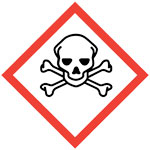



Find all of your laboratory and workplace safety supplies at Safety Emporium!
 Dermal |
 Glossary Index |
 Dermatitis |
| MSDS Topics |
Free Sites | FAQ's | Regulations | Glossary | Software | Suppliers |
| Books | Forum | Poll | Fun stuff | Quiz | Store | |
| Understand your MSDS with the MS-Demystifier | Search ALL our MSDS info | |||||
Dermal toxicity is the ability of a substance to poison people or animals by contact with the skin.
Under Appendix A of OSHA's Hazard Communication Standard, 29 CFR 1910.1200, acute dermal toxicity (from a single exposure) refers to adverse (harmful) effects occurring following dermal administration of a single dose of a substance to the skin, or multiple doses given within 24 hours. Paragraph A.1.2 of Appendix A outlines the hazard classification process for substances.
This classification process assigns an acute toxicity category of 1 through 4 with 1 being the most toxic and 4 the least according to these criteria for pure substances:
| Category 1 | Category 2 | Category 3 | Category 4 |
≤ 50 |
>50 and ≤ 200 |
>200 and ≤ 1000 |
>1000 and ≤ 2000 |
These values have units of mg/kg of body weight and are typically assigned on the basis of rat or rabbit studies. When the substance is a mixture of chemicals, the Standard lays out a series of principles to assign the hazard classification Category based on the acute dermal toxicity of each component and its percentage in the mixture.
If the hazard classification falls into Category 1, 2, or 3, the label and SDS must use the acute toxicity pictogram (a skull and crossbones within a red-framed diamond) and signal word:

See these enties for additional information on skin exposure to toxic or corrosive materials:
Dermal toxicity (if known and applicable) will be reported in Section 11 (toxicological information) of the material's Safety Data Sheet.
Toxic materials absorb through the skin to various degrees depending on their chemical composition and whether they are dissolved in a solvent.
Always wear proper personal protective equipment (PPE) such as gloves and aprons when working with a toxic (or nontoxic) substance that can be absorbed through the skin.
Proper glove selection is critical when working with chemicals. Latex or nitrile gloves do not protect against certain chemicals and solvents. In fact, wearing the wrong gloves has lead to death; see our entry on personal protective equipment for additional resources as well as the glove selection guide under Further Reading (below).
See also: cutaneous, dermal, dermatitis, PPE, vesicant.
Additional definitions from Google and OneLook.
Entry last updated: Sunday, July 10, 2022. This page is copyright 2000-2025 by ILPI. Unauthorized duplication or posting on other web sites is expressly prohibited. Send suggestions, comments, and new entry desires (include the URL if applicable) to us by email.
Disclaimer: The information contained herein is believed to be true and accurate, however ILPI makes no guarantees concerning the veracity of any statement. Use of any information on this page is at the reader's own risk. ILPI strongly encourages the reader to consult the appropriate local, state and federal agencies concerning the matters discussed herein.